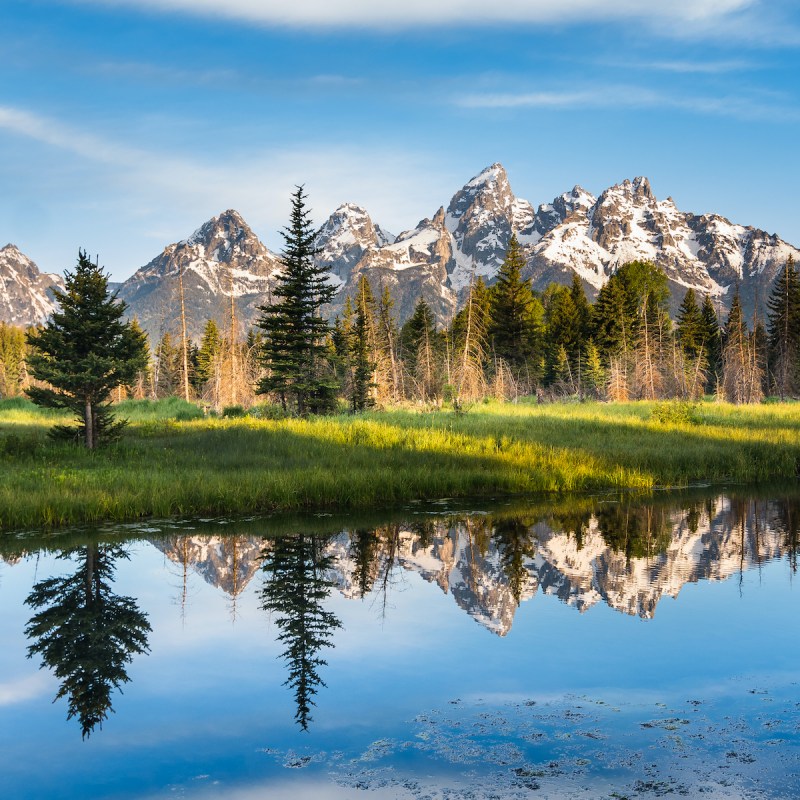
(Pat Tr / Shutterstock.com)
All entrances to Yellowstone National Park may be closed due to hazardous conditions stemming from the recent flooding, but nearby Grand Teton National Park is open and operating normally.
Videos by TravelAwaits
Grand Teton National Park, located in the Rocky Mountains’ Teton Range, is just outside Jackson Hole, Wyoming, and about 100 miles south of Yellowstone. The park features more than 300,000 acres of valleys, mountain meadows, lakes, and rugged mountain peaks, and is well known for being home to large numbers of bears, elk, bison, mule deer, and pronghorn.
Amazingly, Grand Teton set a new attendance record in 2021, logging just under 3.9 million visitors. That record tops the previous high number of recreation visits in 2018, when slightly less than 3.5 million people visited the park, according to the National Park Service (NPS).
“Grand Teton looks forward to welcoming visitors this summer,” the NPS explains. “The summer season is expected to be BUSY, so make sure to plan ahead, recreate responsibly, and help ensure this iconic landscape may be enjoyed by future generations.”
Since this is expected to be a busy summer at the park, the NPS has released what it calls “Have a #GrandPlan for visiting Grand Teton this summer,” written by the park rangers who work at Grand Teton.
Let’s get right to it. Here’s what the rangers want you to know as you plan a trip to Grand Teton this summer.
1. Plan Ahead
“All entrances to Yellowstone are closed. Travelers planning to visit Grand Teton should note that under current conditions, it is more important than ever to plan out your visit, especially where you plan to spend the night,” the rangers explain. “You should also expect there will be many other people visiting the park and plan accordingly.”
Here’s what the rangers want you to know while you’re planning a trip to Grand Teton. First of all, reservations are not required to enter Grand Teton, however entrance fees are required. You can pay that entrance fee at the Moose and Moran entrance stations or online at Recreation.gov.
Secondly, reservations are required for lodging and at all campgrounds in Grand Teton. As a reminder, car camping or sleeping overnight in vehicles is not allowed in park pullouts, parking areas, picnic grounds, or any place other than a designated campground.
You can learn more about camping at Grand Teton here.
Also, due to current high levels of COVID-19 in the local community, face masks are now required in all park buildings in Grand Teton — regardless of visitors’ vaccination status.
2. Put A Ranger In Your Pocket
Rangers recommend downloading the National Park Service App before you arrive at Grand Teton.
Here’s why: The NPS App provides interactive maps, tours of park places, and on-the-ground accessibility information about more than 400 national parks to make trip planning easier. The free app can be downloaded through the App Store and Google Play.
You can learn more about the NPS App here.
3. “Bear” With Us
“Be alert,” the rangers explain. “Grizzly and black bears are active in Grand Teton, including in developed areas.”
Rangers urge park visitors to always stay 100 yards away from bears and wolves. Also, when they aren’t being actively used, all items that have an odor should be stored in a bear-resistant food storage locker or inside a hard-sided vehicle with the doors locked and windows closed.
You can learn more about how to “Be bear aware” and recreate safely in bear country here.
4. Keep The “Wild” In “Wildlife”
It’s critical to be safe in bear country, but rangers remind park visitors to keep a safe distance from all wildlife. It’s also important to note that it is illegal to feed any wildlife, including bears, as well as ground squirrels and foxes.
Finally, while wildlife is often visible from the road, visitors should keep the road clear. To do that, drivers should use pullouts or pull completely off the roadway to the right of the white line when they stop to view wildlife.
5. It’s “Ruff” For Dogs In The Park
“Grand Teton is a wild place” that isn’t always the best place to take dogs, the rangers explain.
Visitors need to keep in mind that although pets are allowed inside Grand Teton, dogs are not allowed on trails, pathways, inside visitor centers, or in park waters. And, of course, dogs must be restrained at all times in places where they are allowed.
You can learn more about visiting Grand Teton with pets here.
6. Crowds Are Late To Rise And Early To Set
Grand Teton draws a high number of visitors each year. Consequently, it’s difficult to find parking in the park during peak hours. To avoid crowds and increase your chances of finding parking spaces, rangers suggest arriving at the park either before 9 a.m. or after 4 p.m.
7. Slow Down!
“Be vigilant while driving,” rangers note. “Slowing down could save a life.”
Rangers remind all drivers to obey posted speed limits and maintain a safe following distance from other vehicles.
Furthermore, drivers will need to be alert for roadside pedestrians and follow adjusted speed limits in high visitation areas such as Mormon Row, Taggart Lake, Jenny Lake, and Colter Bay.
8. “Give The Smolder The Cold Shoulder”
There are two important tips to remember about campfires in Grand Teton. First, they are only allowed in designated and installed fire rings. Secondly, campfires should always be attended to and must be completely “dead out” and cold to the touch before visitors leave a campsite, the rangers note.
You can learn about current fire conditions at Grand Teton here.
9. It’s Okay To Ghost Us And “Leave No Trace”
Rangers ask all visitors to recreate responsibly by disposing of trash properly and following Leave No Trace Principles by packing out what they take in. As you expect, recycling is available throughout the park.
You can learn more about the Seven Principles of Leave No Trace, including “Dispose of Waste Properly” and “Leave What You Find,” here.
10. Remember There’s More To Explore
If you’re planning to visit Grand Teton, remember that Jackson Hole and Wyoming are full of other places to explore, the rangers conclude. You can learn more about nearby attractions, including Bighorn Canyon National Recreation Area, Devils Tower National Monument, and the Bridger-Teton National Forest here.
While you’re thinking about a trip, be sure to read all of our Grand Teton National Park content, including
